Family name: Ecdeiocoleaceae D. F. Cutler & Airy Shaw
Synonym(s): [none]
Common name(s): ecdeiocolea family
*Number of genera/species: 2/3
List of genera records in GRIN-Global
fruit or seed
Fruit an achene (Ecdeiocolea), globoseglobose:
3D shape—more or less spherical , angledangular:
, angledangular:
2D shape—having sides that meet at acute or obtuse angles
in transection, tepalstepal:
a member of the perianth, when it cannot be differentiated into a calyx and corolla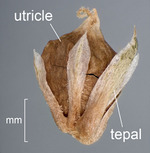 , pedicelpedicel:
, pedicelpedicel:
the stalk of a flower
, and stylestyle:
in a flower, the narrow and elongated part of the pistil between the stigma and the ovary; sometimes persisting in fruit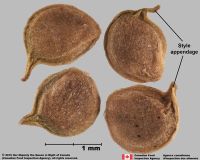 persistent, stylestyle:
persistent, stylestyle:
in a flower, the narrow and elongated part of the pistil between the stigma and the ovary; sometimes persisting in fruit forms a beakbeak:
forms a beakbeak:
a usually firm, terminal appendage, sometimes tapered in E. rigens. In Georgeantha, fruits are globoseglobose:
in E. rigens. In Georgeantha, fruits are globoseglobose:
3D shape—more or less spherical , loculicidalloculicidal:
, loculicidalloculicidal:
type of capsular dehiscence, opening longitudinally through the locules (compare septicidal)
 capsulescapsule:
capsulescapsule:
a dry, dehiscent fruit derived from a compound ovary , angledangular:
, angledangular:
2D shape—having sides that meet at acute or obtuse angles
in transection, and with prominently thickened valvevalve:
in fruits, one of the parts into which a fruit separates at maturity
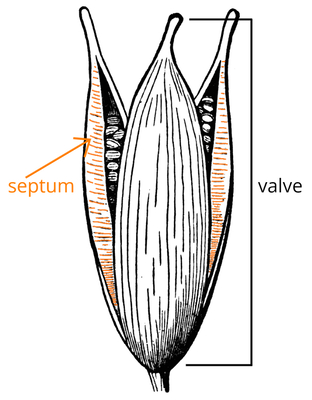 margins. Fruits 2.5–4 mm long. Pericarppericarp:
margins. Fruits 2.5–4 mm long. Pericarppericarp:
fruit wall or fruit coat
brown, smooth or wrinkledwrinkled:
surface relief—shallow, irregular folds and furrows covering the surface; appearing overall though crumpled and then spread out (E. rigens).
(E. rigens).
Seeds ellipsoidellipsoid:
3D shape—elliptic
, 1.5–2 mm long, tereteterete:
approximately circular in cross section; width and thickness approximately equal
 in transection, reticulatereticulate:
in transection, reticulatereticulate:
surface relief—netted, raised walls or concave grooves forming a net-like surface pattern with flat, concave, or convex interspaces .
.
Embryo minute, straight.
Endosperm copious.
| Fruit | |
| Type | acheneachene: a dry, indehiscent, one-seeded fruit, with seed attached to pericarp at a single point, derived from a single, superior, simple or compound, one-loculed ovary 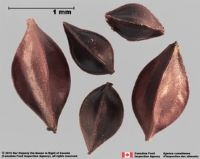 |
| Size range | 2.5–4 mm long |
| Shape(s) | globoseglobose: 3D shape—more or less spherical  |
| Surface relief | smooth or wrinkledwrinkled: surface relief—shallow, irregular folds and furrows covering the surface; appearing overall though crumpled and then spread out  |
| Color(s) | brown |
| Unique features | Small achenesachene: a dry, indehiscent, one-seeded fruit, with seed attached to pericarp at a single point, derived from a single, superior, simple or compound, one-loculed ovary  or 3-locular capsulescapsule: or 3-locular capsulescapsule:a dry, dehiscent fruit derived from a compound ovary  with a few strongly reticulatereticulate: with a few strongly reticulatereticulate:surface relief—netted, raised walls or concave grooves forming a net-like surface pattern with flat, concave, or convex interspaces  seeds. seeds. |
| Seed | |
| Size range | 1.5–2 mm long |
| Shape(s) | ellipsoidellipsoid: 3D shape—elliptic |
| Surface relief | reticulatereticulate: surface relief—netted, raised walls or concave grooves forming a net-like surface pattern with flat, concave, or convex interspaces  |
| Unique features | Small, strongly reticulatereticulate: surface relief—netted, raised walls or concave grooves forming a net-like surface pattern with flat, concave, or convex interspaces  seeds with minute embryos and copious endosperm. seeds with minute embryos and copious endosperm. |
| Other | |
| Embryo | minute, straight |
| Nutritive tissue | endosperm copious |
Southwestern Australia.
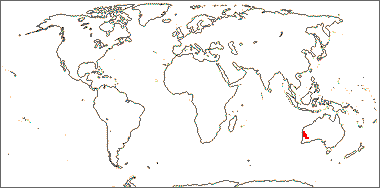
Distribution map courtesy of Angiosperm Phylogeny Website.
Baskin and Baskin 2021Baskin and Baskin 2021:
Baskin C and Baskin J. 2021. Relationship of the lateral embryo (in grasses) to other monocot embryos: A status up-grade. Seed Science Research 31 (3): 199-210. doi:10.1017/S0960258521000209; Briggs and Johnson 1998Briggs and Johnson 1998:
Briggs BG and Johnson LAS. 1998. Georgeantha hexandra , a new genus and species of Ecdeiocoleaceae (Poales) from Western Australia. Telopea: Journal of Plant Systematics 7 (4): 307-312.; Dahlgren et al. 1985Dahlgren et al. 1985:
Dahlgren RMT, Clifford HT, and Yeo PF. 1985. The families of the monocotyledons: structure, evolution, and taxonomy. Springer-Verlag, Berlin. 520 pp.; Flora of Australia 2021+Flora of Australia 2021+:
Flora of Australia. Australian Biological Resources Study, Canberra. Accessed January 2021–March 2024. URL: http://www.ausflora.org.au; Kirkbride et al. 2006Kirkbride et al. 2006:
Kirkbride JH, Jr, Gunn CR, and Dallwitz MJ. 2006. Family guide for fruits and seeds, vers. 1.0. Accessed September 2020-January 2022. URL: https://nt.ars-grin.gov/seedsfruits/keys/frsdfam/index.cfm .; Kubitzki et al. 1990+Kubitzki et al. 1990+:
Kubitzki K et al., eds. 1990+. The families and genera of vascular plants. 7+ vols. Berlin etc.; Stevenson and Loconte 1995Stevenson and Loconte 1995:
Stevenson DW and Loconte H. 1995. A cladistic analysis of monocot families. In: Rudall PJ, Cribb PJ, Cutler DF, and Humphries CJ, eds. Monocotyledons: Systematics and Evolution. Royal Botanic Gardens, Kew.; Thiselton-Dyer 1897Thiselton-Dyer 1897:
Thiselton-Dyer WT. 1897. Flora capensis: being a systematic description of the plants of the Cape colony, Caffraria, amp; Port Natal (and neighbouring territories). Vol. 7. L. Reeve, Kent UK. 791 pp. https://doi.org/10.5962/bhl.title.821
*The number of genera and species is based on Christenhusz and Byng 2016Christenhusz and Byng 2016:
Christenhusz MJM and Byng JW. 2016. The number of known plant species in the world and its annual increase. Phytotaxa 261 (3): 201-217. https://doi.org/10.11646/phytotaxa.261.3.1, which may differ from the number of genera in GRIN-Global.
|
For fruit and seed images see Flora of the World.
|